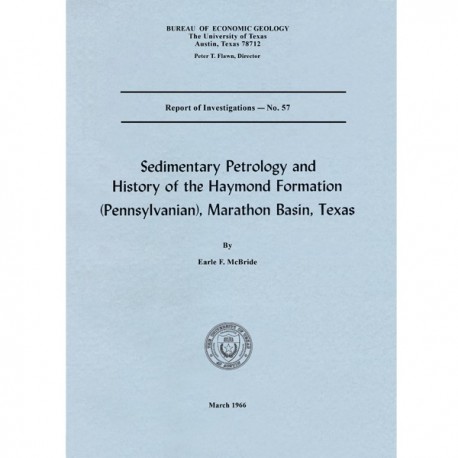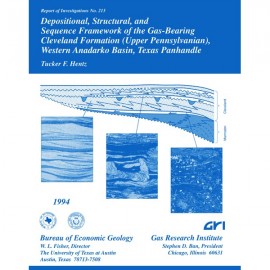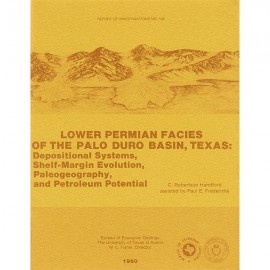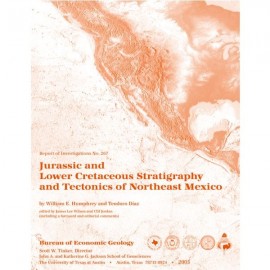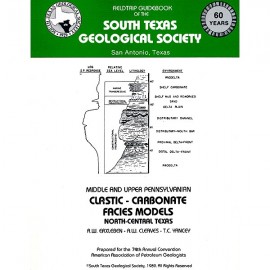Reports of Investigations
-
Books & Reports
- Reports of Investigations
- Guidebooks
- Udden Series
- Geological Circulars
- Down To Earth
- Atlases of Major Oil and Gas Reservoirs
- Texas Memorial Museum Publications
- Environmental Geologic Atlas of the Texas Coastal Zone
- Mineral Resource Circulars
- Other Reports
- Seminars and Workshops
- Handbooks
- Submerged Lands of Texas
- Symposia
- Annual Reports
- Open File Reports
-
Maps & Cross Sections
- Thematic Maps
- Miscellaneous Maps, Charts & Sections
- Geologic Atlas of Texas
- STATEMAP Project Maps
- Geologic Quadrangle Maps
- Cross Sections
- Highway Geology Map
- Energy and Mineral Resource Maps
- Shoreline Change and Other Posters
- Wilcox Group, East Texas, Geological / Hydrological Folios
- Bouguer Gravity Atlas of Texas
- River Basin Regional Studies
- Featured Maps
- Posters
- Teachers & the Public
-
Geological Society Publications
- Gulf Coast Association of Geological Societies
- Alabama Geological Society
- Austin Geological Society
- Corpus Christi Geological Society
- Houston Geological Society
- Lafayette Geological Society
- Mississippi Geological Society
- New Orleans Geological Society
- South Texas Geological Society
- GCS SEPM Publications
- Historic BEG & UT Series
Sedimentary Petrology and History of the Haymond Formation (Pennsylvanian), Marathon Basin, Texas
RI0057
Sedimentary Petrology and History of the Haymond Formation (Pennsylvanian), Marathon Basin, Texas, by E. F. McBride. 101 p., 14 figs., 25 plates, 1966. ISSN: 0082335X:Print. Print Version.
A free, digital version of this publication can be found on: Texas ScholarWorks
RI0057. Sedimentary Petrology and History of the Haymond Formation (Pennsylvanian), Marathon Basin, Texas, by E. F. McBride. 101 p., 14 figs., 25 plates, 1966. ISSN: 0082335X:Print.
To purchase this publication as a downloadable PDF, please order RI0057D.
From the Introduction
This report treats the sedimentary petrology and history of the Haymond Formation, a monotonous sequence of interbedded sandstone and shale that has a maximum preserved thickness of 4,300 feet. The upper part of the formation includes massive coarse sandstone beds and a complex of pebbly mudstones and slumped beds that encase exotic and erratic rock fragments up to 130 feet long. The Haymond is part of a 12,000-foot sequence of flysch that was deposited during late Paleozoic time in the Marathon geosyncline, a part of the Ouachita geosyncline located in Trans-Pecos Texas. The formation is exposed on a structurally high part of the Ouachita structural belt, most of which is known only in the subsurface in Texas...within the topographic Marathon Basin, a sub-rectangular area that has dimensions of 50 miles in a NE-SW direction and 35 miles in a NW-SE direction. Deformed Paleozoic rocks trend NE-SW in the Basin and are exposed through a veneer of Quaternary alluvium; the Basin is rimmed by Permian rocks to the northwest (Glass Mountains) and by Cretaceous rocks in other directions.
Paleozoic sedimentary rocks that have a composite thickness of approximately 15,000 feet were deposited in the geosyncline. The rocks were folded and thrust-faulted as the result of crustal shortening that culminated during late Pennsylvanian time and subsequently faulted and domed during Mesozoic and Tertiary time (P. B. King, 1937). Flysch of Mississippian and Pennsylvanian age comprises nearly 12,000 feet of the geosynclinal sequence. The Haymond is the youngest flysch unit; it is separated from the Tesnus, a siliciclastic flysch unit similar in many respects to the Haymond...by the Dimple Limestone, a calcarenite-shale flysch unit... Older Paleozoic rocks in the Basin are chert, novaculite, limestone, and shale, with lesser amounts of sandstone and conglomerate that have a total thickness of approximately 3,000 feet.
The Haymond is of sedimentologic interest because of the problems of the mode of emplacement of the erratic and exotic rocks of the boulder beds and of the deposition of innumerable alternations of sandstone and shale; in addition, it is of interest as a partial record of the geologic history of the Marathon geosyncline.
Keywords: sediments, petrology, sedimentary petrology, Haymond Formation, Marathon Basin, Ouachita, Paleozoic, Texas
Citation
McBride, E. F., 1966, Sedimentary Petrology and History of the Haymond Formation (Pennsylvanian), Marathon Basin, Texas: The University of Texas at Austin, Bureau of Economic Geology, Report of Investigations No. 57, 101 p.
